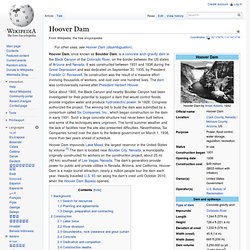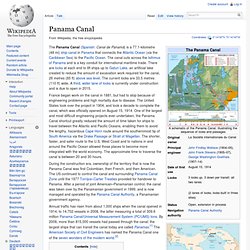

Hoover Dam. Since about 1900, the Black Canyon and nearby Boulder Canyon had been investigated for their potential to support a dam that would control floods, provide irrigation water and produce hydroelectric power.

Panama Canal. Location of Panama between Pacific (bottom) and Caribbean (top), with canal at top center The Panama Canal (Spanish: Canal de Panamá) is a 77.1-kilometre (48 mi) ship canal in Panama that connects the Atlantic Ocean (via the Caribbean Sea) to the Pacific Ocean.

The canal cuts across the Isthmus of Panama and is a key conduit for international maritime trade. There are locks at each end to lift ships up to Gatun Lake, an artificial lake created to reduce the amount of excavation work required for the canal, 26 metres (85 ft) above sea level. The current locks are 33.5 metres (110 ft) wide. A third, wider lane of locks is currently under construction and is due to open in 2015. France began work on the canal in 1881, but had to stop because of engineering problems and high mortality due to disease. First Transcontinental Railroad. Transcontinental Railroad 75th Anniversary Issue of 1944 Opened for through traffic on May 10, 1869, with the driving of the "Last Spike" with a silver hammer at Promontory Summit,[4] the road established a mechanized transcontinental transportation network that revolutionized the settlement and economy of the American West by bringing these western states and territories firmly and profitably into the "Union" and making goods and transportation much quicker, cheaper and much more flexible from coast to coast.

History[edit] Title page of Dr. Hartwell Carver's 1847 Pacific Railroad proposal to Congress Completion of a Pacific railroad was the culmination of a decades-long movement to build such a line beginning as early as 1832 when Dr. London sewerage system. The new Abbey Mills Pumping Station The London sewerage system is part of the water infrastructure serving London, England. The modern system was developed during the late 19th century, and as London has grown the system has been expanded. It is currently owned and operated by Thames Water and serves almost all of Greater London. History[edit] River Thames around 1840 Interior of the Octagon at Crossness showing its elaborate decorative ironwork, which was heavily influenced by Moorish imagery The original Abbey Mills pumping station During the early 19th century the River Thames was an open sewer, with disastrous consequences for public health in London, including cholera epidemics. The intercepting sewers, constructed between 1859 and 1865, were fed by 450 miles (720 km) of main sewers that, in turn, conveyed the contents of some 13,000 miles (21,000 km) of smaller local sewers.
Modern development needs[edit] Thames Tideway Scheme[edit] Literary or media references[edit] See also[edit] Notes. Brooklyn Bridge. Originally referred to as the New York and Brooklyn Bridge and as the East River Bridge, it was dubbed the Brooklyn Bridge, a name from an earlier January 25, 1867, letter to the editor of the Brooklyn Daily Eagle,[7] and formally so named by the city government in 1915. Since its opening, it has become an icon of New York City, and was designated a National Historic Landmark in 1964[6][8][9] and a National Historic Civil Engineering Landmark in 1972.[10] Construction[edit] John Augustus Roebling The Brooklyn Bridge was initially designed by German immigrant John Augustus Roebling, who had previously designed and constructed shorter suspension bridges, such as Roebling's Delaware Aqueduct in Lackawaxen, Pennsylvania, Waco Suspension Bridge in Waco, Texas, and the John A.
Roebling Suspension Bridge in Cincinnati, Ohio. Bell Rock Lighthouse. The masonry work on which the lighthouse rests was constructed to such a high standard that it has not been replaced or adapted in 200 years.[3] The lamps and reflectors were replaced in 1843 and used in the lighthouse at Cape Bonavista, Newfoundland, where they are currently on display.[4] The working of the lighthouse has been automated since 1988.[1] The lighthouse operated in tandem with a shore station, the Bell Rock Signal Tower, built in 1813 at the mouth of Arbroath harbour. Today this building houses the Signal Tower Museum, a visitor centre detailing the history of the lighthouse. The challenges faced in the building of the lighthouse have led to it being described as one of the Seven Wonders of the Industrial World. History[edit] According to legend, the rock is called Bell Rock because of a 14th-century attempt by the Abbot of Arbroath to install a warning bell on it.
SS Great Eastern. Brunel knew her affectionately as the "Great Babe". He died in 1859 shortly after her ill-fated maiden voyage, during which she was damaged by an explosion. After repairs, she plied for several years as a passenger liner between Britain and North America before being converted to a cable-laying ship and laying the first lasting transatlantic telegraph cable in 1866.[4] Finishing her life as a floating music hall and advertising hoarding (for the famous department store Lewis's) in Liverpool, she was broken up in 1889.